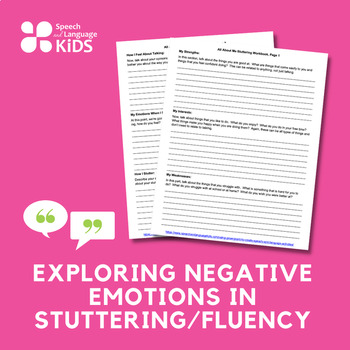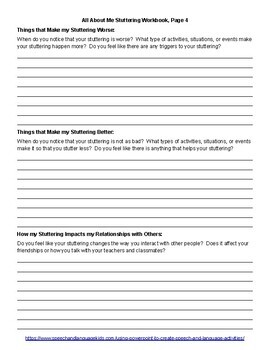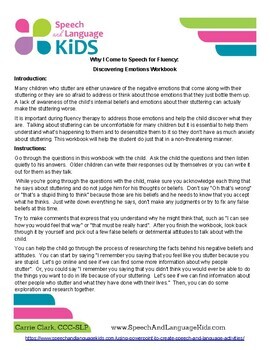Exploring Negative Emotions in Stuttering/Fluency Workbook - Speech Therapy
- PDF
Description
Workbook with 15 questions for children who stutter to start exploring how they feel about stuttering and how it affects their lives. The questions start with general questions about their strengths and weaknesses (not related to speaking) and gradually move into talking about their stuttering itself. This is a great tool to use by speech-language pathologists when trying to find out what underlying negative beliefs or emotions are impacting their client's stuttering. Information gained from this exercise can be then used in therapy to address those underlying thoughts and beliefs.
Need more resources on this? We have a whole no-prep kit that will walk you through increasing awareness of stuttering and addressing these negative beliefs and emotions. This workbook is included inside that larger program.
Click here to view the larger program: https://www.teacherspayteachers.com/Product/Dealing-With-Awareness-Emotions-in-StutteringDisfluency-Speech-Therapy-Plan-5165021
Addressing Negative Thoughts and Beliefs about Stuttering in Children:
Many children who stutter are either unaware of the negative emotions that come along with their stuttering or they are so afraid to address or think about those emotions that they just bottle them up. A lack of awareness of the child’s internal beliefs and emotions about their stuttering can actually make the stuttering worse. It is important during fluency therapy to address those emotions and help the child discover what they are.
Talking about stuttering can be uncomfortable for many children but it is essential to help them understand what’s happening to them and to desensitize them to it so they don’t have as much anxiety about stuttering. This workbook will help the student do just that in a non-threatening manner.
How to Use this Workbook:
Go through the questions in this workbook with the child. Ask the child the questions and then listen quietly to his answers. Older children can write their responses out by themselves or you can write it out for them as they talk.
While you’re going through the questions with the child, make sure you acknowledge each thing that he says about stuttering and do not judge him for his thoughts or beliefs. Don’t say “Oh that’s wrong” or “that’s a stupid thing to think” because those are his beliefs and he needs to know that you accept what he thinks. Just write down everything he says, don’t make any judgments or try to fix any false beliefs at this time.
Try to make comments that express that you understand why he might think that, such as “I can see how you would feel that way” or “that must be really hard”.
After you finish the workbook, look back through it by yourself and pick out a few false beliefs or detrimental attitudes to talk about with the child. You can help the child go through the process of researching the facts behind his negative beliefs and attitudes. You can start by saying “I remember you saying that you feel like you stutter because you are stupid. Let’s go online and see if we can find some more information about why people stutter”. Or, you could say “I remember you saying that you didn’t think you would ever be able to do the things you want to do in life because of your stuttering. Let’s see if we can find information about other people who stutter and what they have done with their lives.” Then, you can do some exploration and research together.
Who is this For?
This workbook is targeted toward any child who stutters and is able to talk about his/her thoughts and beliefs regarding stuttering. Speech-language pathologists and psychologists are specifically trained to help children who stutter with these negative thoughts and beliefs so these professionals would be best suited to use this product with a child. Parents can use these questions as well to gain understanding of their child's mindset. However, we recommend doing this in conjunction with a speech-language pathologist or psychologist so you have someone to help address any powerful emotions that come up.
Need more resources on this?
We have a whole no-prep kit that will walk you through increasing awareness of stuttering and addressing these negative beliefs and emotions. This workbook is included inside that larger program.
Click here to view the larger program: https://www.teacherspayteachers.com/Product/Dealing-With-Awareness-Emotions-in-StutteringDisfluency-Speech-Therapy-Plan-5165021




